
Mirbelia is a plant genus belonging to the family Fabaceae and is endemic to Australia, occurring in every mainland state except South Australia. Plants in the genus Mirbelia are prickly, perennial shrubs with simple, sometimes sharply-pointed leaves, or the leaves absent. The flowers are arranged singly or in groups in leaf axils or on the ends of branches, the sepals joined at the base with five teeth. The petals are usually red, orange, purplish or bluish and the fruit is an inflated pod.
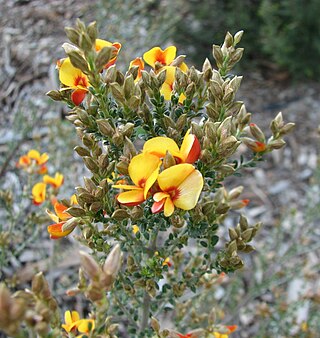
Mirbelia oxylobioides, commonly known as mountain mirbelia or sandstone bushpea, is a species of flowering plant in the family Fabaceae and is endemic to south-eastern Australia. It is a low-lying or erect shrub with narrowly elliptic to egg-shaped leaves and orange-yellow and reddish-purple flowers arranged near the end of the branches.

Pultenaea juniperina, commonly known as prickly bush-pea or prickly beauty is a species of flowering plant in the family Fabaceae and is endemic to south-eastern Australia. It is an erect, spiky shrub with hairy stems, linear to narrow elliptic leaves with stipules at the base, and yellow-orange and red flowers.
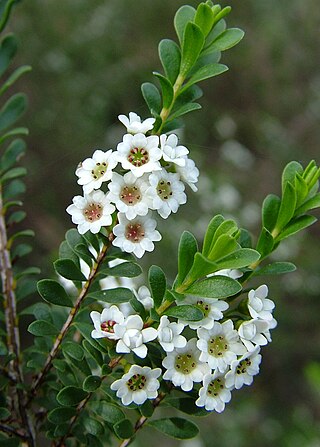
Thryptomene calycina, commonly known as Grampians thryptomene, is a species of flowering plant in the family Myrtaceae and is endemic to Victoria in Australia. It is an erect or spreading shrub with oblong, elliptic or egg-shaped leaves with the narrower end toward the base, and white flowers with five stamens.

Mirbelia speciosa is a species of flowering plant in the family Fabaceae and is endemic to eastern Australia. It is an erect shrub with narrowly linear leaves arranged in whorls of three, and bluish-purple flowers usually arranged singly in leaf axils.
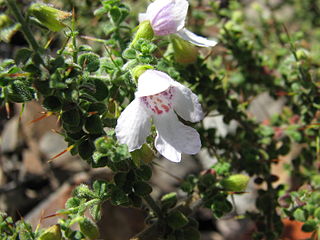
Prostanthera arapilensis is a flowering plant in the family Lamiaceae and is endemic to a small area of Victoria, Australia. It is an erect shrub with hairy branches, broadly egg-shaped to more or less round leaves and pale mauve or white flowers with orange-brown spots or streaks inside the petal tube.
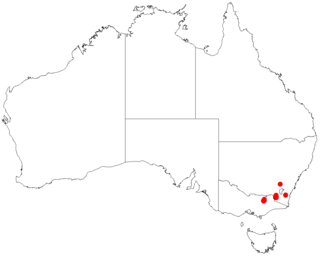
Prostanthera monticola, commonly known as Buffalo mint-bush, is a species of flowering plant in the family Lamiaceae and is endemic to higher areas of south-eastern Australia. It is a sprawling, open shrub with red, hairy branches, lance-shaped to narrow elliptic leaves and pale bluish-green to grey-green flowers with dark purple-blue veins.

Cryptandra amara, commonly known as bitter cryptandra or pretty pearlflower, is a species of flowering plant in the family Rhamnaceae and is endemic to eastern Australia. It is a densely-branched shrub with clustered, more or less linear to egg-shaped or elliptic leaves, and tube-shaped white flowers arranged on the ends of branchlets.

Cryptandra ericoides, commonly known as heathy cryptandra, is a species of flowering plant in the family Rhamnaceae and is endemic to south-eastern continental Australia. It is a wiry, low-lying to erect shrub with often clustered, cylindrical leaves, and tube-shaped white flowers arranged in clusters on the ends of branchlets.

Pultenaea dentata, commonly known as clustered bush-pea, is a species of flowering plant in the family Fabaceae and is endemic to south-eastern Australia. It is an erect to low-lying or prostrate, open shrub with elliptic to narrow egg-shaped leaves and dense clusters of yellow, red and purple flowers.

Epacris acuminata, commonly known as claspleaf heath, is a species of flowering plant in the heath family Ericaceae and is endemic to Tasmania. It is a small, spreading shrub with egg-shaped, stem-clasping leaves and tube-shaped flowers with white petals.
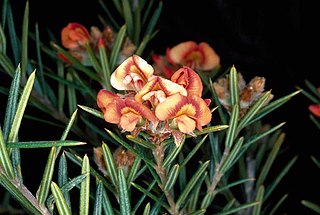
Mirbelia confertiflora is a species of flowering plant in the family Fabaceae and is endemic to eastern Australia. It is a rigid, bushy shrub with linear leaves and yellow to orange flowers arranged in racemes near the end of the branches.
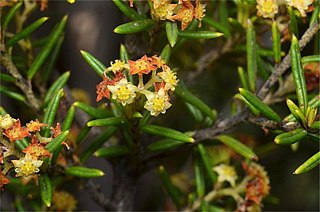
Spyridium daltonii is a species of flowering plant in the family Rhamnaceae and is endemic to Victoria in Australia. It is a shrub with softly-hairy branchlets, linear to narrowly elliptic leaves, and small groups of hairy, yellowish flowers.

Mirbelia pungens, commonly known as prickly mirbelia, is a species of flowering plant in the family Fabaceae and is endemic to south-eastern continental Australia. It is an erect or prostrate shrub with sharply-pointed linear leaves and orange-red flowers with blue or purple markings.
Mirbelia rhagodioides is a species of flowering plant in the family Fabaceae and is endemic to inland areas of Western Australia. It is an erect, prickly shrub with clustered linear or narrowly elliptic leaves and yellow and red flowers.
Spyridium × ramosissimum, commonly known as branched spyridium, is a species of flowering plant in the family Rhamnaceae and is endemic to Victoria in Australia. It is a small shrub with woolly-hairy branches, egg-shaped leaves, and crowded heads of hairy flowers with brown bracts.
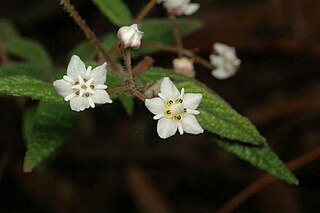
Commersonia rugosa is a species of flowering plant in the family Malvaceae and endemic to New South Wales. It is an open, straggly shrub with linear to narrowly egg-shaped leaves with irregular teeth or lobes on the edges, and white flowers in clusters of 3 to 15.

Androcalva reticulata is a species of flowering plant in the family Malvaceae and is endemic to north-eastern Queensland. It is a low shrub that forms suckers, its new growth covered with star-shaped hairs, and has egg-shaped leaves with irregular teeth on the edges, and groups of two to six red flowers.

Leucopogon thymifolius, commonly known as thyme beard-heath, is a species of flowering plant in the heath family Ericaceae and is endemic to Victoria. It is a slender shrub with spreading, egg-shaped to oblong leaves and white to pale pink, tube-shaped flowers arranged in spikes of seven to thirteen in leaf axils, or on the ends of leafless branches.

Leucopogon virgatus, commonly known as common beard-heath, is a species of flowering plant in the heath family Ericaceae and is endemic to south-eastern Australia. It is an erect to low-lying shrub with linear to narrowly lance-shaped or egg-shaped leaves, and erect clusters of three to seven white, tube-shaped flowers on the ends of branches and in upper leaf axils.



















